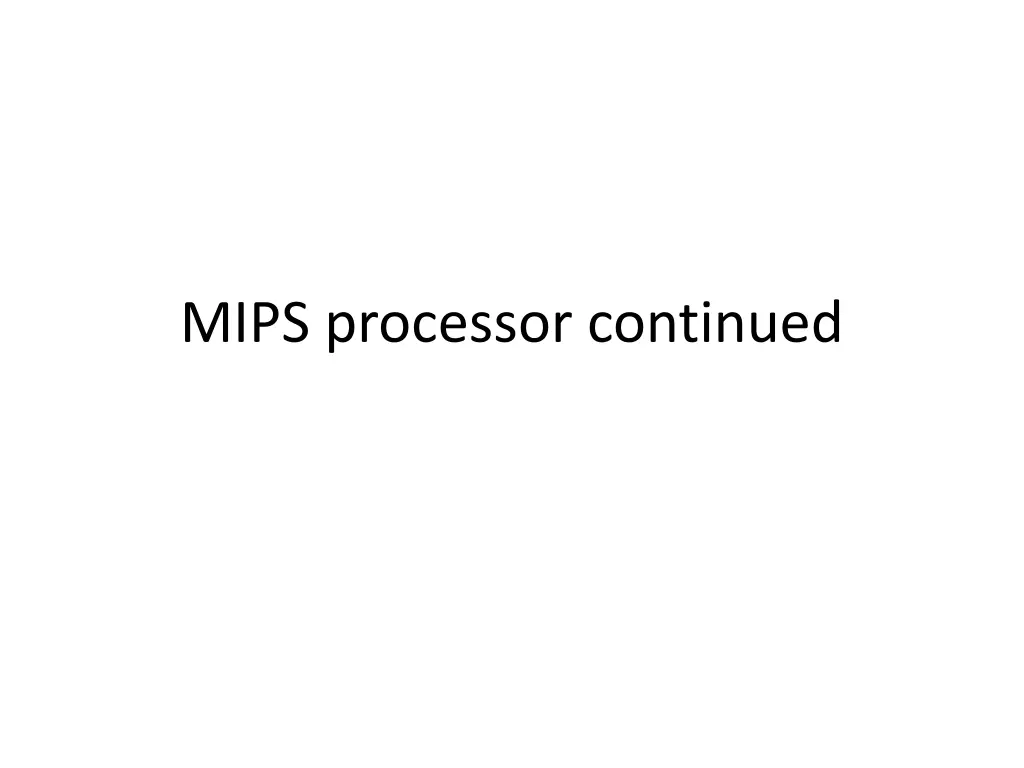
Understanding MIPS Processor Operations for Efficient Functionality
Explore the intricate connections and data paths within a MIPS processor, including the implementation of instructions like lw, sw, beq, and more. Discover the datapaths for R-type, memory type, and branch operations, along with control signals for managing different instructions effectively.
Download Presentation

Please find below an Image/Link to download the presentation.
The content on the website is provided AS IS for your information and personal use only. It may not be sold, licensed, or shared on other websites without obtaining consent from the author. If you encounter any issues during the download, it is possible that the publisher has removed the file from their server.
You are allowed to download the files provided on this website for personal or commercial use, subject to the condition that they are used lawfully. All files are the property of their respective owners.
The content on the website is provided AS IS for your information and personal use only. It may not be sold, licensed, or shared on other websites without obtaining consent from the author.
E N D
Presentation Transcript
Review Different parts in the processor should be connected appropriately to be able to carry out the functions. Connections depending on what we need Learnt R-type, lw, sw, beq
Data path for both R-type and memory-type instructions add $rd, $rs, $rt, format: opcode (6 bits) rs (5 bits) rt (5 bits) rd (5 bits) 00000 funct (6 bits) lw $rt, offset_value($rs): opcode (6 bits) rs (5 bits) rt (5 bits) offset (16 bits) sw $rt, offset_value($rs): opcode (6 bits) rs (5 bits) rt (5 bits) offset (16 bits)
Data path for both R-type and memory-type instructions add $rd, $rs, $rt, format: opcode (6 bits) rs (5 bits) rt (5 bits) rd (5 bits) 00000 funct (6 bits) lw $rt, offset_value($rs): opcode (6 bits) rs (5 bits) rt (5 bits) offset (16 bits) sw $rt, offset_value($rs): opcode (6 bits) rs (5 bits) rt (5 bits) offset (16 bits)
Datapath for R-type, memory, and branch operations
Datapath for R-type, memory, and branch operations (Answer)
Datapath for Memory, R-type and Branch Instructions, plus the control signals
Jump Instruction Jump instruction seems easy to implement We just need to replace the lower 28 bits of the PC with the lower 26 bits of the instruction shifted by 2 bits The shift is achieved by simply concatenating 00 to the jump offset 11/15/2007 5:02:11 PM week-13-3.ppt 11
Implementing Jumps The one we have supports arithmetic/logic instructions, branch instructions, load and store instructions We need also to support the jump instruction 31 26 25 0 0 0 0 0 1 0 opcode Address What are the changes we need to make? 12
Questions Which statement is true about the datapath below? a) The data path supports lw. b) The data path supports sw. c) Both of the above. d) None of the above.
Questions Which statement is true about the datapath below? a) The data path supports lw. b) The data path supports sw. c) Both of the above. d) None of the above.
Questions The following datapath supports R-type, lw, sw, and beq. Which of the following statements is true if we decide to support less instructions? a) If only to support R-type and lw, we need exactly 3 2-1 MUX. b) If only to support R-type and beq, we need exactly 2 2-1 MUX. c) Both of the above. d) None of the above.
Questions Consider the MIPS processor that supports the R-type, lw, sw, and beq instructions. Suppose $t0 is holding 9, $t1 is holding 4, the data memory location 4*i is holding value i, when we encounter the following instruction: beq $t0, $t1, L1 where L1 is the 4th instruction after the beq instruction. Suppose the control signal for a 2-1 MUX is 0 if we do not care about its value. What will be the stable values showing at ports WriteData of the register file and WriteData of the data memory during the execution of this instruction? (a) 1 and 9. (b) 5 and 4. (c) 20 and 4. (d) None of the above.
In Class Exercise Supporting Jump Register and R-type 11/25/2007 10:54:43 PM week-14-1.ppt 19
Performance Assume that Memory access: 200ps ALU and adders: 100 ps Register file read: 50ps Register file write: 10ps (the clk-to-q delay) PC update: 10ps (the clk-to-q delay) The setup time of DFFs: 10ps Other parts do not have delay How fast is An R-type instruction? A lw instruction? A sw instruction? A beq instruction? Need to find the critical path the longest path
R-type PC ready instruction ready register ready ALU ready register written So, the clock needs to be at least 10+200+50+100+10 = 370ps Will there be a problem if the next instruction is also an R-type instruction, considering that the register is written and stable only after the next rising edge of the clock? Figure not to the exact scale
lw PC ready instruction ready register ready ALU ready Data mem ready register written So, the clock needs to be at least 10+200+50+100+200+10 = 570ps Figure not to the exact scale
beq PC ready instruction ready register ready ALU ready Adder 1 ready Adder 2 ready So, it is 10+200+50+100+10 = 370ps Figure not to the exact scale
Clock cycle So, how long should the clock cycle be? Is it efficient?
